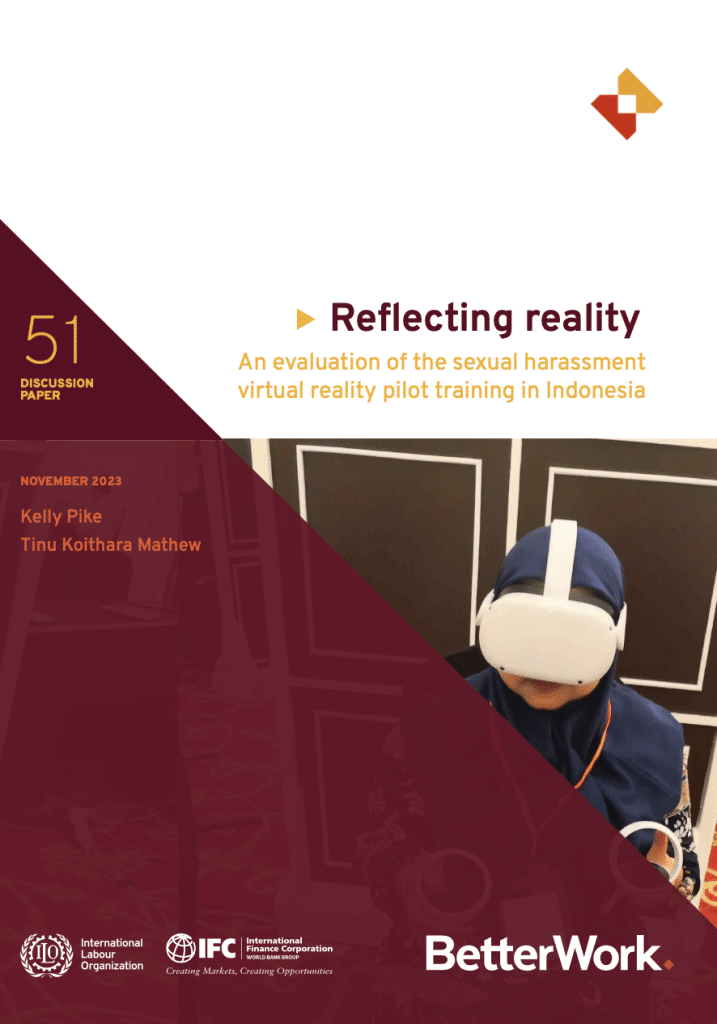Authors: Kelly Pike and Tinu Koithara Mathew
This study focuses on Better Work’s Virtual Reality training programme on sexual harassment prevention in Indonesia.
Sexual harassment and gender-based violence (GBV) are pressing issues in the global garment industry, perhaps more so during the pandemic when people are facing increased economic and social hardship. According to World Health Organisation estimates, 1 in 3 women globally experience GBV and women, especially young women, are most affected by this violence and harassment when they work at the bottom of the global supply chain. Through targeted and systemic approaches to sexual harassment awareness, prevention and remediation, Better Work (BW)-facilitated trainings on sexual harassment prevention have been introduced and are an important intervention in workplace GBV across BW’s eight country programs. The current study conducted an empirical analysis of the ILO Better Work’s Virtual Reality (VR) training program on sexual harassment prevention in Indonesia. The main objectives were to assess the trainings’ impact on (1) increase in awareness of sexual harassment, including its definition and what constitutes it, and (2) increase the likelihood of intervention by bystanders who witness sexual harassment in the workplace.
Through in-depth interviews, 360° feedback tool, focus group discussions, and through a post- test 1.5 month survey with managers, compliance officers and worker representatives who have attended the VR training and also with those who work closely with them, the study examined to what extent they learned what was intended, to what extent they put learning into effect when back at work, any noticeable behavioural change, and future behaviour or intentions with respect to prevention of sexual harassment.
Overall, findings indicate that improvements have been made in the levels of recognition of sexual harassment through a general enthusiasm and excitement around an immersive training experience. There is also knowledge building that occurred through exploring and practicing of role plays in a safe environment. Participants shared their learnings with others through formal and informal methods. While participants generally expressed satisfaction around the benefits of VR, a few challenges also emerged as findings of the study. The VR training is designed in English and so the language barrier prevented some participants from effective learning. There was no opportunity for the participants to ask questions like in a traditional training. The likelihood of intervening depends on the context of relationship and opportunity for dialogue and some participants wanted it to be defined in the VR training. Social norms also play a key role in how participants perceive things.
The study participants were able to provide suggestions to improve the VR training from a content and logistics perspective, and overall, they felt that VR training can add value to the prevention of sexual harassment in the workplace. The biggest finding was that the participants demonstrated signs of behaviour change in the direction of the intended sexual harassment prevention. The increased awareness made them careful in their interactions and have started to think about different ways to disseminate the information that they gained through training. They have also started to think about sexual harassment in the context of occupational health and safety in factories.
Although Better Work virtual reality pilot sexual harassment training program has helped to improve basic recognition of sexual harassment as a workplace issue and was able to trigger a positive behaviour change, there is much to be done to effectively implement the training programs drawing from the feedback received through this study. Also, in order to observe the behaviour change more clearly, a comprehensive and focussed assessment is needed.
